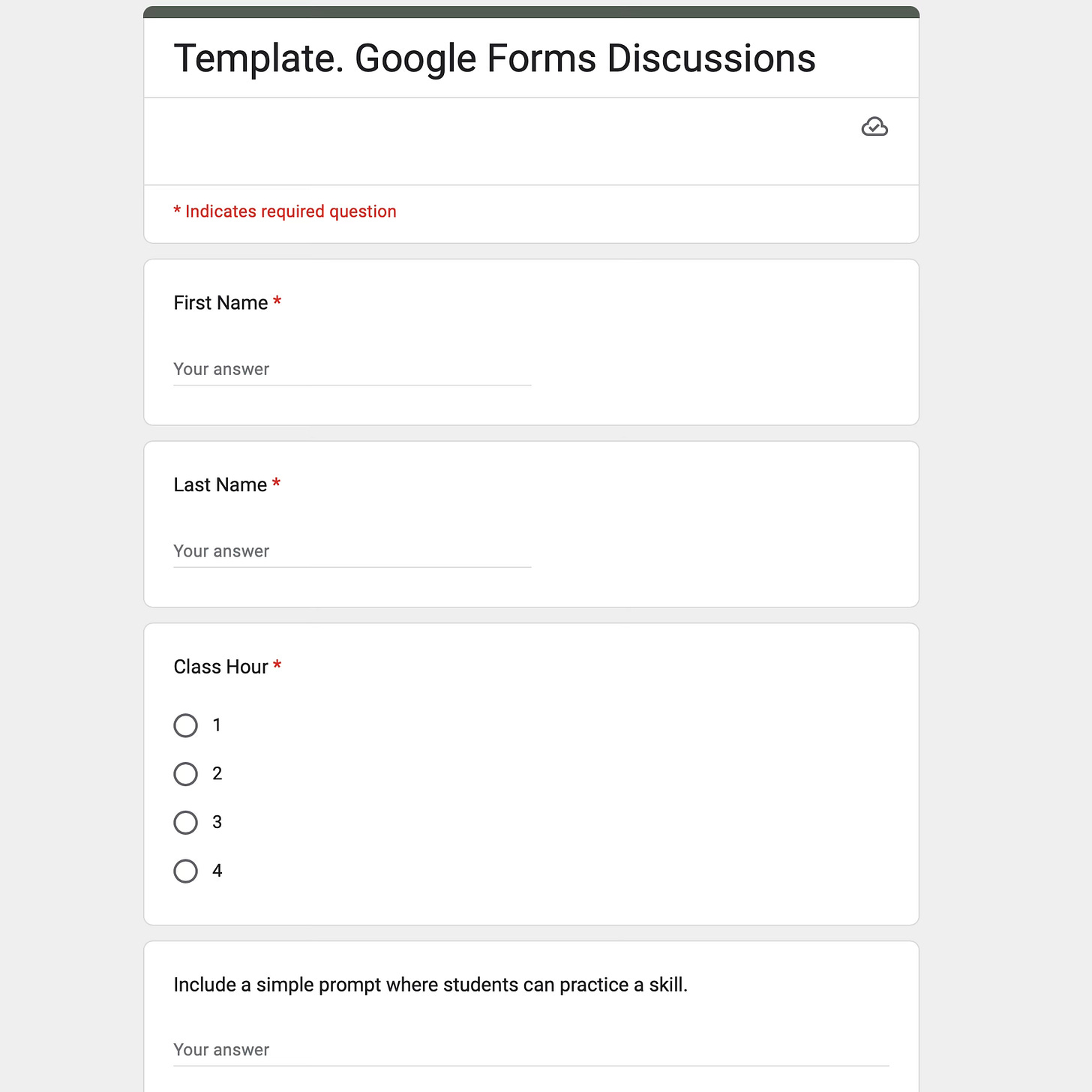🖥️ Five Ways Google Forms Help Teach Writing (+ Template)
Google Forms Discussions allow real-time writing feedback and easy data collection.
Google Forms (GF) might be the best writing tool you don't use. While it allows easy data collection (surveys and polls), it also allows real-time writing feedback and easy archiving. Over time, student archives snowball and generate better examples and more authentic writing assignments.
The Big Picture. GF discussions replace the traditional entrance and exit ticket along with managing scores of little papers. They provide easy data collection both for attitudes (through surveys) and results (through writing).
Try at any point during the learning process—before, during, and after a skill—then repeat across tasks to demonstrate growth.
Year to year, managing these discussions involve duplicating forms and adjusting fields.
How It Works. GF discussions require little preparation. They work through simply displaying typed responses on the main board.
Step 1. Create a Google Form for a particular writing skill. (Don't forget to ask for names and class hours for easy grading!)
Step 2. Load the page on your classroom screen before class begins. Note that responses appear on the editing page-screen and not the preview.
Step 3. Once students have submitted answers, change tabs and discuss the responses. Afterwards, responses populate a spreadsheet, allowing for easy grading.
Five Fast Benefits. When students write once for a teacher, the writing becomes disposable. But when they regularly write for each other, the social element takes over. They up their game. (Imagine a digitally blended workshop.) You might also expect the following:
1. No paper scraps. This needs repeated: Digitize traditional entrance and exit slips. Print and grade a spreadsheet instead.
2. Real-time feedback. Give feedback and discuss examples as a class. Results remain anonymous unless students type their names or shout otherwise.
3. Easy data collection. Spreadsheets skip digitizing any work from paper. When repeated across stages in the learning process, writing samples live on easily accessible sheets.
4. Crowd sourced examples. For English teachers, digital writing samples should be worth gold. As you collect responses, begin with richer examples and move ever forwards.
5. Easy archives. Group examples however, but embrace easy go-to’s. Be students of student writing, and your knowledge will grow accordingly. But form archives from the beginning.
Example Workflow. Every year I teach students how to write letters and emails, but I’ve lacked the follow through with assignments. Here's a workflow I'm working through:
Previously, students hand wrote example email responses on common topics—questions on grades, missed classes, and so on.
This week students wrote an email where they purposely broke a rule. (They selected the rule or rules with a checkbox.)
We discussed the results as a class, pointing out errors in form (greetings and closings), content (vague responses), tone (unintentional disrespect), and so on.
Now that I have dozens of student-generated responses, I'll have a starting point for my next assignment: Students will critique these emails and say what needs to be fixed.
When presenting these ideas next year, I’ll likewise have a small catalogue of errors.
Zoom Out. Corporate textbooks will never match the richness of student-generated writing. In short, student writing helps students write. While GF works for collecting short writing samples, learning management systems (LMS) work for longer samples. I plan on detailing using LMSs for collecting and curating writing this fall.
✍️ Want to try it? Feel free to steal this basic template. I promise there’s not much to it!
Update! Check out my follow up post on why we should teach using student writing. Also, I’ve written a follow up that addresses how to categorically exclude certain response types in Google Forms.
📚 While you’re here, check out some other posts:
📱 Also, check out some other posts from my side blog, HappyCasserole.







Right after reading this, I worked Microsoft Forms more into my online courses. It is so helpful!
(I know, I’d rather use Google Forms too. But I’m actually not allowed.)
Very cool, Adam. This post is a great example of picking the low hanging fruit and making a beautiful cobbler of a feast. The idea at the center is this: Student writers view writing they do for teachers as disposable. They view writing that actually gets read by peers as worth keeping. That’s teaching for student ownership of their work and their learning. 🙏